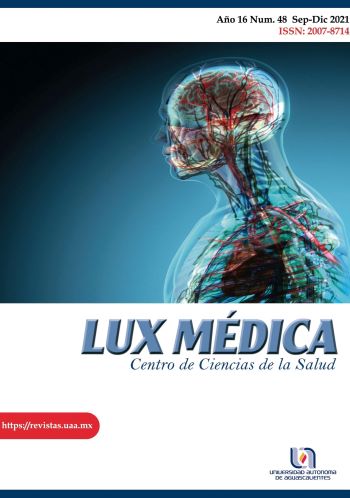Relationship between body composition and symptoms in women with fibromyalgia from Aguascalientes
DOI:
https://doi.org/10.33064/48lm20213269Keywords:
Body composition, Fibromyalgia, FIQ, Obesity.Abstract
Introduction: Fibromyalgia is a disease with several complications that affect nutritional status. Altered body composition levels (high adiposity or sarcopenia) are conditioning factors for the control and appearance of clinical manifestations. Objective: To describe the association of body composition and fibromyalgia symptoms. Materials and Methods: Descriptive cross-sectional study, volunteers: 27 women with fibromyalgia from Aguascalientes, Mexico. Fibromyalgia impact questionnaire (FIQ) was applied to collect data on symptoms; For body composition, a body control scale (OMRON HBF-514C) was used to analyze weight, fat mass, muscle mass, and visceral fat. Results: volunteers presented a BMI of 28.9 ± 5.4. Malnutrition, normal-weight, overweight, and obesity rates were 3.7%, 25.9%, 29.6%, and 40.7%, respectively. 66.7% of patients presented an extremely increased percentage of fat, 22.9% obtained a high percentage, only 11.1% presented healthy levels for her age. Normal, high, and very high-fat percentages, nor in BMI concerning total FIQ score were different. Relationship between body composition and clinical variables obtained in the FIQ showed that there is no significant association. Conclusions: There was no significant relationship between body composition and fibromyalgia symptoms. However, there is evidence to show otherwise. The prevalence of obesity and overweight is high in patients with fibromyalgia being important to continue studies to establish the relationship between these conditions, generating an adequate comprehensive treatment in the future.
Downloads
Published
How to Cite
Issue
Section
License
Copyright (c) 2021 Alma Karina Esparza Santillán , Andrea Mariana Hernández Ramírez, Denniss Jaquelin Muñoz Hermosillo , Ricardo E Ramírez Orozco

This work is licensed under a Creative Commons Attribution-NonCommercial-ShareAlike 4.0 International License.
La revista Lux Médica está bajo una licencia de Creative Commons Reconocimiento-NoComercial-Compartir Igual 4.0 Internacional.












